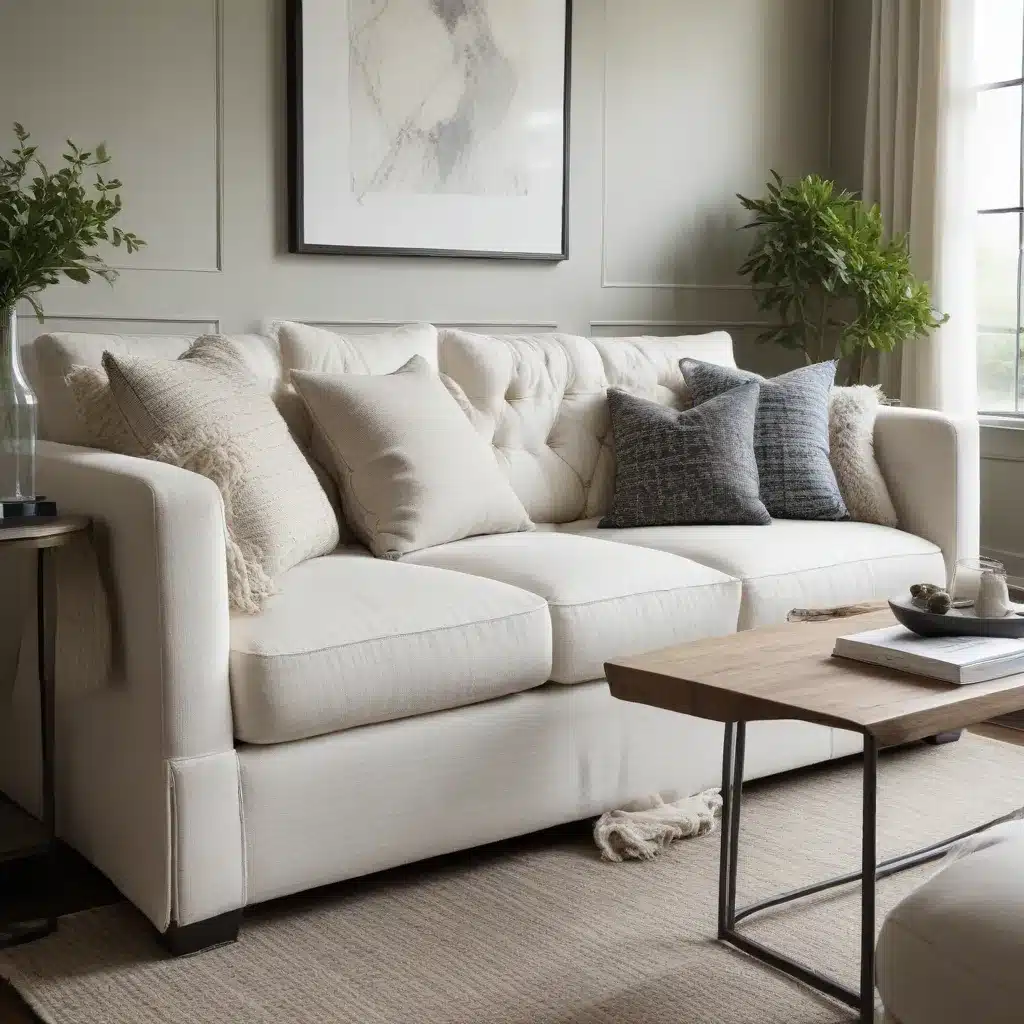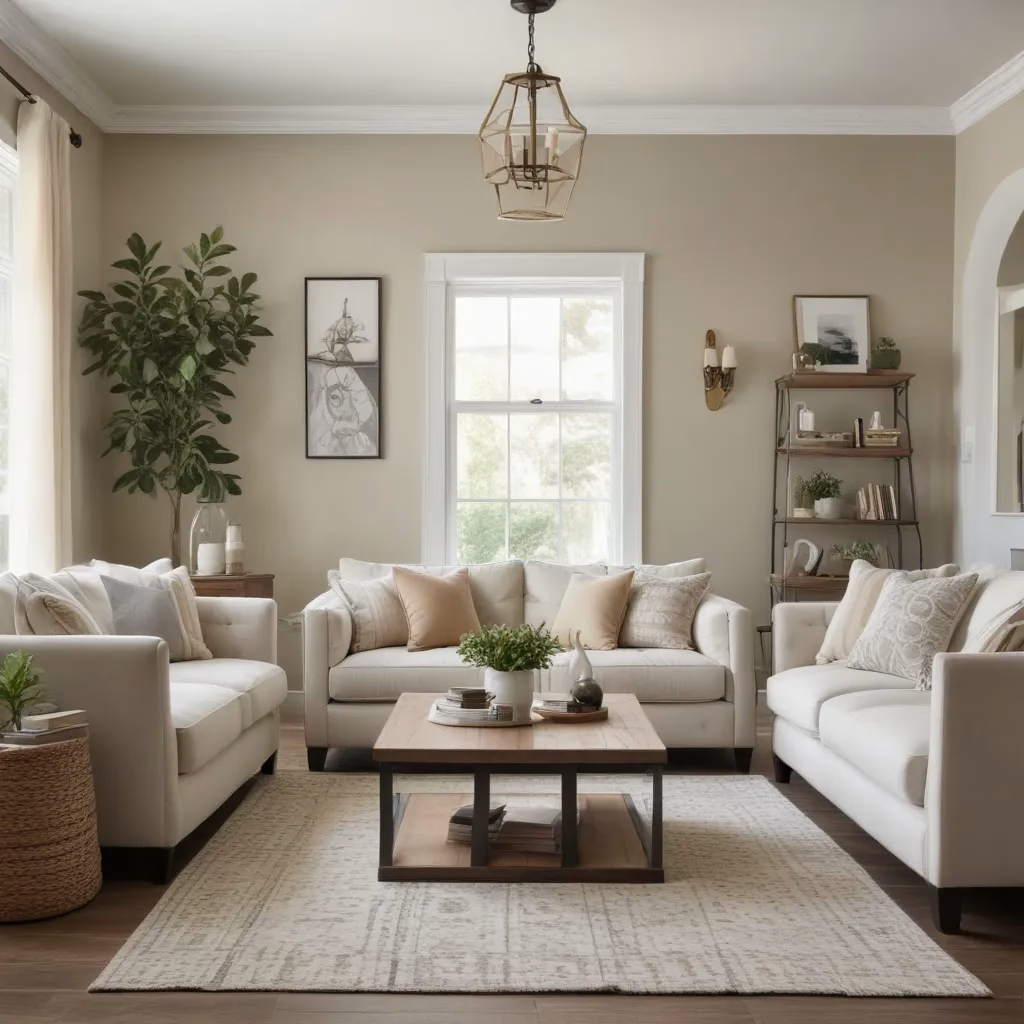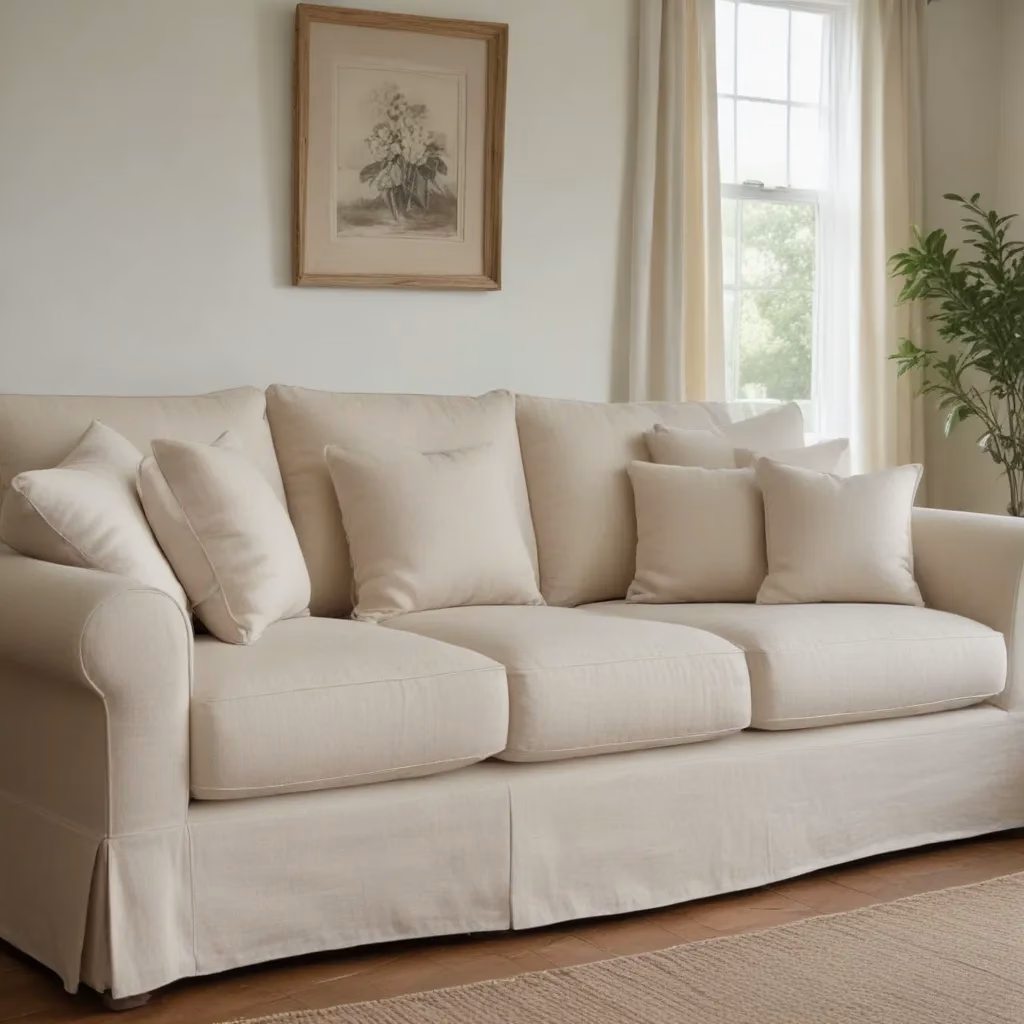
The Art of Textural Interplay in Sofa Design
As a furniture specialist with years of experience in the industry, I’ve seen countless sofa designs come and go. However, one trend that continues to captivate both designers and homeowners alike is the use of high-low textural contrasts. This technique not only adds visual interest to a sofa but also creates a tactile experience that can transform the entire ambiance of a room.
When we talk about high-low textural contrasts, we’re referring to the juxtaposition of different fabric textures within the same piece of furniture. This could be as subtle as combining a smooth leather with a slightly nubby linen, or as dramatic as pairing a plush velvet with a rough-hewn burlap. The key is in the interplay between these textures, which creates depth and dimension that flat, single-texture sofas simply can’t match.
I’ve found that clients are often drawn to sofas with textural contrasts without even realizing why. There’s something inherently appealing about the visual and tactile variety it offers. It’s not just about how the sofa looks, but how it feels when you run your hand over its surface. This sensory experience can make a sofa feel more luxurious and inviting, encouraging people to sit down and truly relax.
Choosing Complementary Textures for Your Sofa
Selecting the right combination of textures for your sofa is crucial to achieving a harmonious look. In my experience, it’s best to start with a base texture that complements your overall interior design style. For instance, if you have a modern, minimalist space, you might choose a smooth, tightly woven fabric as your primary texture.
From there, you can introduce contrasting elements. Let’s say you’ve opted for a sleek, flat-weave wool as your base. You might then add accent pillows in a chunky knit or a faux fur throw to create that high-low contrast. The smooth base provides a neutral backdrop that allows the more textured elements to stand out.
I always advise my clients to consider the practical aspects of their texture choices as well. While a bouclé fabric might look stunning, it may not be the best choice for a household with pets or small children. On the other hand, a leather sofa can be incredibly durable and easy to clean, making it a great option for high-traffic areas. By balancing aesthetics with functionality, you can create a sofa that’s both beautiful and practical.
The Role of Color in Textural Contrast
When working with high-low textural contrasts, color plays a significant role in the overall impact of your sofa design. I’ve found that there are two primary approaches to color when dealing with multiple textures:
-
Monochromatic Scheme: This involves using different textures in the same color family. For example, you might have a charcoal gray velvet sofa body with lighter gray linen pillows and a dark gray wool throw. This approach allows the textures to take center stage without competing with bold color contrasts.
-
Complementary Colors: Here, you use colors that sit opposite each other on the color wheel, combined with different textures. Picture a navy blue leather sofa with mustard yellow velvet pillows and a cream-colored knit throw. The color contrast adds another layer of visual interest to the textural differences.
In my years of working with clients, I’ve noticed that the monochromatic approach tends to work well in more formal or minimalist settings, while the complementary color scheme can add a playful, eclectic touch to a room. Ultimately, the choice depends on your personal style and the overall aesthetic you’re aiming for in your space.
Incorporating Textural Elements Beyond the Sofa
While we’re focusing on sofas, it’s important to remember that textural contrasts shouldn’t exist in isolation. To create a cohesive look in your living space, consider how you can extend these textural elements to other parts of the room. This doesn’t mean everything needs to match perfectly, but rather that there should be a sense of harmony and connection.
For instance, if you have a sofa with a smooth leather base and textured linen pillows, you might echo this contrast in your window treatments. You could pair sleek, modern blinds with linen curtains, creating a similar high-low textural interplay. Or, you might choose a rug that complements one of the textures in your sofa design, tying the whole room together.
I often recommend to my clients that they think about texture in layers. Start with your largest pieces – like your sofa – and then build outwards. Add throw pillows, blankets, and smaller decor items that introduce new textures while still relating to your central piece. This layered approach creates depth and interest throughout the room, making the space feel thoughtfully designed and inviting.
Maintaining Textured Sofas: A Guide to Care and Cleaning
One question I frequently encounter from clients is how to properly care for sofas with multiple textures. It’s a valid concern – after all, different materials often require different cleaning methods. Here’s a general guide I’ve developed over the years:
-
Regular Maintenance: Regardless of texture, all sofas benefit from regular vacuuming. Use a soft brush attachment to gently remove dust and debris from the surface. For leather sections, a weekly wipe-down with a slightly damp cloth can help maintain its appearance.
-
Spot Cleaning: For most fabric textures, blotting spills immediately with a clean, dry cloth is crucial. Avoid rubbing, as this can work the stain deeper into the fibers. For tougher stains, consult the manufacturer’s guidelines or a professional cleaner.
-
Professional Cleaning: I recommend having textured sofas professionally cleaned at least once a year. Professional cleaners have the expertise to handle different materials without causing damage.
-
Protecting from Sunlight: Direct sunlight can fade and damage many types of upholstery. If possible, position your sofa away from windows or use UV-protective window films.
-
Rotating Cushions: To ensure even wear, rotate and flip cushions regularly. This is especially important for sofas with varying textures, as some materials may show wear more quickly than others.
Remember, prevention is always better than cure. Using arm covers or throws on high-use areas can help protect your sofa and extend its lifespan. And of course, always check the care label or consult with the manufacturer for specific cleaning instructions for your particular sofa.
The Future of Textural Design in Sofas
As we look to the future of sofa design, I believe we’ll see even more innovative approaches to textural contrasts. Advancements in fabric technology are continually expanding the possibilities for what we can achieve in terms of texture and durability.
One exciting development I’ve been following is the creation of “smart” fabrics that can change texture or appearance based on temperature or touch. Imagine a sofa that feels cool and smooth in the summer but transforms to a warm, fuzzy texture in winter. While this technology is still in its early stages, it hints at the potential for truly dynamic textural experiences in our furniture.
Another trend I’m seeing is a move towards more sustainable and eco-friendly textures. This includes fabrics made from recycled materials, as well as natural fibers that are produced using environmentally responsible methods. These materials often have unique textures that can add an organic, earthy feel to a sofa design.
As a furniture specialist, I’m always excited to see how designers and manufacturers push the boundaries of what’s possible with sofa textures. Whether it’s through new materials, innovative weaving techniques, or creative combinations of existing textures, there’s always something new to discover in the world of sofa design.
Choosing the Right Textural Contrast for Your Home
When it comes to selecting the perfect high-low textural contrast for your sofa, there’s no one-size-fits-all solution. The right choice depends on a variety of factors, including your personal style, the existing decor in your home, and your lifestyle needs. Here are some considerations I always discuss with my clients:
-
Style Compatibility: The textures you choose should complement your overall interior design style. For a modern, minimalist space, you might opt for sleek leather contrasted with a fine-knit fabric. In a more traditional setting, a combination of smooth velvet and textured brocade could work beautifully.
-
Color Scheme: Consider how the textures will interact with your color palette. Sometimes, using contrasting textures in similar colors can create a sophisticated, monochromatic look. Other times, pairing different textures with complementary colors can make a bold statement.
-
Functionality: Think about how you use your sofa. If it’s in a high-traffic area or if you have pets, you might want to choose more durable textures for the main body of the sofa and save the more delicate textures for accent pillows or throws.
-
Scale: The size of your sofa and your room should influence your texture choices. Large-scale textures can overwhelm a small space, while very fine textures might get lost in a grand room.
-
Seasonality: Consider how your textural choices will feel throughout the year. A sofa that’s cozy and inviting in winter should still be comfortable in the warmer months.
Remember, the goal is to create a sofa that not only looks great but feels wonderful to sit on and enhances your daily living experience. Don’t be afraid to mix and match samples and trust your instincts – often, the combinations that feel right to you will be the ones that work best in your space.
The Psychology of Texture in Interior Design
As a furniture specialist, I’ve always been fascinated by the psychological impact of texture in interior design, particularly when it comes to sofas – the centerpiece of most living spaces. The textures we choose for our furniture can significantly influence our mood, comfort level, and even our behavior in a room.
Soft, plush textures like velvet or chenille tend to evoke feelings of comfort and luxury. They invite touch and can make a space feel more welcoming and cozy. On the other hand, smoother textures like leather or tightly woven fabrics can create a sense of sleekness and modernity, often making a space feel more organized and streamlined.
When we introduce high-low textural contrasts in a sofa, we’re essentially creating a multi-sensory experience. The interplay between different textures stimulates our sense of touch and sight, making the sofa – and by extension, the room – more engaging and interesting.
I’ve noticed that clients often gravitate towards sofas with textural contrasts in spaces where they want to encourage relaxation and social interaction. The varied textures seem to spark curiosity and invite people to sit, touch, and explore, making the sofa a true focal point of the room.
Textural Contrasts and Sofa Longevity
One aspect of high-low textural contrasts that I always discuss with my clients is how this design choice can impact the longevity of their sofa. In my experience, sofas with thoughtfully chosen textural contrasts can actually wear better over time than those with a single texture.
The reason for this is twofold. First, by incorporating different textures, you’re distributing wear across various materials. Each texture will age differently, which can add character to the sofa over time rather than showing uniform wear.
Secondly, the ability to easily change out certain textural elements – like pillows or throws – allows you to refresh the look of your sofa without replacing the entire piece. This not only extends the life of your sofa but also gives you the flexibility to update your decor as your tastes change.
For example, I once worked with a client who chose a sofa with a durable, smooth base fabric and added textural interest through pillows and a throw. Years later, when she wanted to update her living room, we were able to completely transform the look of the sofa simply by changing these accent pieces. The sofa itself was still in excellent condition, thanks to the quality of the base fabric and the distributed wear across the different textures.
Creating a Cohesive Look with Textural Contrasts
While high-low textural contrasts can add fantastic visual interest to a sofa, it’s important to ensure that this design element doesn’t feel disconnected from the rest of your space. As a furniture specialist, I always encourage my clients to think about how their sofa’s textures will interact with other elements in the room.
One effective strategy is to echo your sofa’s textures in other pieces of furniture or decor. For instance, if your sofa features a combination of smooth leather and nubby linen, you might incorporate leather in a nearby armchair and use linen for your curtains. This creates a sense of continuity throughout the space.
Another approach is to use your sofa’s textures as a starting point for a textural theme in the room. If your sofa combines sleek and plush textures, you could extend this theme to other elements – perhaps a sleek metal coffee table paired with a plush area rug.
Remember, the goal isn’t to match everything perfectly, but to create a harmonious flow of textures throughout the space. This approach can make your room feel thoughtfully designed and cohesive, with your textured sofa serving as the anchor for the entire design scheme.
The Impact of Lighting on Textural Contrasts
One often overlooked aspect of working with high-low textural contrasts in sofa design is the role that lighting plays in highlighting these differences. In my years as a furniture specialist, I’ve seen how the right lighting can dramatically enhance the visual impact of textural contrasts.
Natural light, for instance, can beautifully accentuate the differences between smooth and rough textures, especially during the “golden hours” of early morning and late afternoon. The low-angled sunlight casts shadows that emphasize the depth and dimensionality of different textures.
Artificial lighting can be equally effective when used strategically. Overhead lighting can create stark contrasts between high and low textures, while side lighting or uplighting can create softer, more subtle distinctions. I often recommend using a combination of lighting sources to create a layered effect that showcases your sofa’s textural contrasts throughout the day and evening.
For example, I once worked with a client who had a beautiful sofa with a smooth leather base and textured wool pillows. We positioned a floor lamp next to the sofa to cast light across its surface, beautifully highlighting the interplay between the sleek leather and the woolly texture of the pillows. The effect was stunning, turning the sofa into a true piece of art in the room.
Textural Contrasts in Different Design Styles
One of the things I love about high-low textural contrasts in sofa design is how versatile they can be across different interior design styles. Let’s explore how this technique can be applied in various design aesthetics:
-
Modern: In modern design, textural contrasts often involve pairing sleek, smooth surfaces with more tactile elements. A leather sofa with chunky knit throw pillows, for example, creates an interesting juxtaposition that adds warmth to the clean lines typical of modern design.
-
Traditional: Traditional design often incorporates rich textures. Here, you might see a velvet sofa paired with silk pillows and a needlepoint throw, creating a layered, luxurious effect.
-
Scandinavian: This style typically features a mix of cozy and minimalist elements. A linen sofa with furry pillows and a woven wool throw embodies the hygge concept central to Scandinavian design.
-
Bohemian: Boho style is all about mixing textures. You might find a sofa upholstered in a smooth, neutral fabric but adorned with pillows and throws in a variety of textures – think macramé, fringe, and global-inspired woven fabrics.
-
Industrial: In industrial design, the contrast is often between man-made and natural textures. A leather sofa might be paired with rough linen pillows, playing on the juxtaposition of refined and raw materials.
-
Coastal: Coastal design often incorporates natural textures. A sofa in a smooth, sandy-colored fabric might be accented with pillows in chunky cable knit or rough jute, evoking the textures of the beach.
The beauty of textural contrasts is that they can be adapted to suit any style preference. As a furniture specialist, I always enjoy helping clients find the perfect combination of textures to express their personal style while creating a visually interesting and inviting space.
Conclusion
As we’ve explored throughout this article, high-low textural contrasts are a powerful tool in sofa design, capable of adding depth, interest, and character to your living space. From the psychology of texture to practical considerations of maintenance and longevity, there’s much to consider when incorporating this design element into your home.
Remember, the key to successful textural contrast lies in balance – finding the right combination of textures that complement each other and your overall design aesthetic. Whether you’re drawn to the sleek modernity of leather and linen or the cozy luxury of velvet and wool, there’s a textural combination out there that’s perfect for your space.
As you embark on your sofa selection journey, I encourage you to touch, feel, and experience different textures in person whenever possible. And if you’re looking for more inspiration or expert advice, don’t hesitate to visit Sofa Spectacular. Their range of sofas and expertise in textural design can help you find the perfect piece to elevate your living space.
Ultimately, your sofa should be a reflection of your personal style and a source of comfort in your home. By embracing the art of textural contrast, you can create a sofa that’s not just a piece of furniture, but a true design statement.



